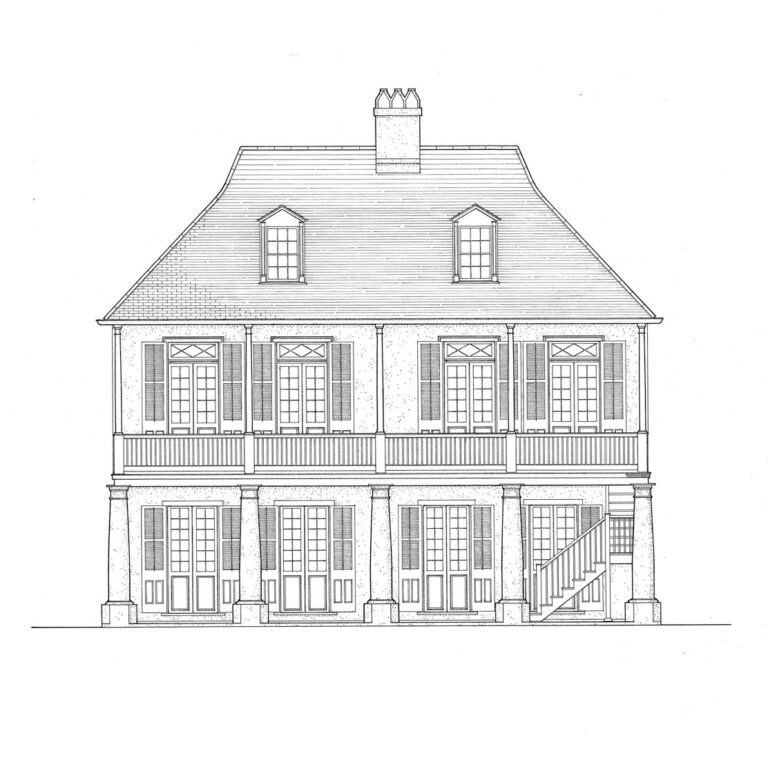The Spanish Custom House is one of the oldest buildings still standing in New Orleans today. Built in 1784, it is said to have been the theatre of many illegal activities and scandals throughout its long life.
Moss Street
Moss Street, located between the neighborhoods of Bayou St. John, Fairgrounds, and Mid-City, offers amazing views of the New Orleans City Park. The park is home to the New Orleans Museum of Modern Art and the Louisiana Children’s Museum. You can count on Moss Street for a relaxing stroll along Bayou St. John, but the city center is only a short car ride away with its gorgeous river views, museums, and other famous historic houses! We recommend enjoying a drink at Lafitte’s Blacksmith Shop, marveling at the architecture of the Hermann-Grima House, and exploring the horror stories surrounding the LaLaurie Mansion!
The Origins of the Spanish Custom House
The land on which the Spanish Custom House was built was given to French colonial settlers in 1708 for agricultural purposes, but this didn’t turn out as expected, as growing crops in New Orleans was very difficult at the time.
Santiago Llorens bought the land in 1771, and in 1784, he and his wife built their home, which featured a typical Creole design, as did most houses at this time. Sadly, we don’t know anything about Santiago Llorens, as any documents pertaining to this figure were likely lost or burned in the French Quarter fires at the end of the 18th century. The most important fire, which occurred in 1788, is known as the Great New Orleans Fire and it destroyed 856 of the 1,100 structures in New Orleans at the time, including the church, municipal building, army barracks, armory, and jail.
A Jail for Pirates and Smugglers
The Spanish Customs House was used as a detention site for people who used the bayou for illegal gain, namely pirates and smugglers. These people would then be taken to the Cabildo in the French Quarter to be judged by the Spanish Government. From 1763 until 1803, Louisiana was under colonial Spanish rule, being referred to by settlers as a province of New Spain.
Louisiana is well known for its pirate stories, the most famous being that of Jean Lafitte and his legendary Blacksmith shop, so it’s not surprising that, in the 1700s, the streets and canals of New Orleans were crawling with privateers, smugglers, and more. To this day, New Orleans locals still know the infamous story of Jean Lafitte, a pirate, privateer, and slave trader who operated in the Gulf of Mexico and was killed by Spanish privateers in the Gulf of Honduras.
Despite its name, no records demonstrate that the house was ever actually used as a Custom House, and its name may simply be inspired by its history.
The Many Owners of the Spanish Custom House
The Spanish Custom House has seen many owners come and go, some for longer periods than others. In 1807, for example, Captain Beauregard purchased the property but held it for only 2 years. In 1809, Louis Blanc and Louis Fortin became the next owners of the house. Blanc, in particular, was placed there by the Spanish settler government. A few years later, the Roux family bought the house and kept it until 1901, staying in the property of the same family for almost a century.
In 1927, Helen Pitkin Schertz, the new owner of the Spanish Custom House, had it renovated. Helen Pitkin Schertz was well-known in New Orleans as a civic activist, musician, and writer. Upon her death in 1945, the house sat abandoned for several years until it underwent yet another renovation attempt in the late 1900s, but in the early 2000s, when it went on sale again, the economy and the damage caused by Hurricane Katrina made it impossible to sell it, and it was auctioned in 2009. Its new owner was the only one who successfully restored the house.









